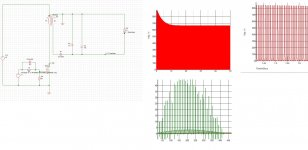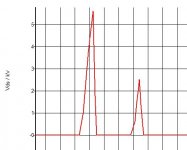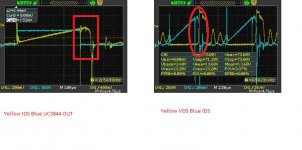zeus_threat
Member
New thread for half bridge started here: http://www.diysmps.com/forums/showthread.php?213-EI-33-based-half-bridge#post1317754696
 this is the simulation result at 100KHz 0.5 DTC any feedback is welcome. the transformer is coiled I need to measure it and set its gap appropriately and the UC3845 controller is working fine. I will assemble the transformer on the board and keep posted. I am planning to run the module to max 110V ac if I manage to get there and nothing blows up. Transformer optimization and high VDs mosfet for 220V will follow afterwards and most probabily some dtc limiting to lower the VDS voltage to a reasonable value
this is the simulation result at 100KHz 0.5 DTC any feedback is welcome. the transformer is coiled I need to measure it and set its gap appropriately and the UC3845 controller is working fine. I will assemble the transformer on the board and keep posted. I am planning to run the module to max 110V ac if I manage to get there and nothing blows up. Transformer optimization and high VDs mosfet for 220V will follow afterwards and most probabily some dtc limiting to lower the VDS voltage to a reasonable value .
. .The core is an EE2511 and the Bmax was set to 300G. I feel I am using a too high magnetizing force or my leakage inductance could be too high but i'll let the comments come in, anyways I will have to rebuild that transfo anyway given the issue. the aim here is once I iron out the issues at low voltage I will then move to build a transformer for 220Vac.
.The core is an EE2511 and the Bmax was set to 300G. I feel I am using a too high magnetizing force or my leakage inductance could be too high but i'll let the comments come in, anyways I will have to rebuild that transfo anyway given the issue. the aim here is once I iron out the issues at low voltage I will then move to build a transformer for 220Vac.